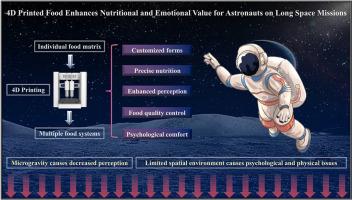Space food 4D additive manufacturing (4D-AM): Insight into food perception science and nutritional supplementation on physical and mental health of astronauts
IF 15.4
1区 农林科学
Q1 FOOD SCIENCE & TECHNOLOGY
引用次数: 0
Abstract
Background
As humanity advances toward the universe, prolonged space missions face dual challenges of maintaining nutritional adequacy and psychological homeostasis amidst unique physiological stressors, especially microgravity-induced metabolic shifts and confinement in closed ecosystems. These conditions exacerbate multisystem health risks of astronauts. The four-dimensional additive manufacturing (4D-AM) system possesses the potential to address the dynamic physiological needs of crew members while alleviating psychological fatigue through enhanced sensory diversity and nutritional adaptability.
Scope and approach
First, this paper systematically describes the development of space food, emphasizing that 4D-AM is a paradigm-shifting technology. It facilitates task-oriented nutritional restructuring, enhances sensory engagement, and enriches psychological well-being through the dynamic deformation of food. The paper further explores how 4D-AM can sustain the relative stability of astronauts' physical and psychological health by modulating human perceptual capabilities and customizing nutritional profiles. Finally, it outlines the multifaceted challenges and future prospects associated with its implementation, including the impact of microgravity on human physiological functions and the necessity of real-time monitoring of astronauts' health.
Key findings and conclusions
4D-AM has the potential to synergize adaptive nutrient delivery with the alleviation of psychological stress, both of which are critical health strategies for interstellar missions. Nevertheless, the standards and processes associated with the 'smart material' aspect of 4D-AM require further standardization and research. Additionally, the accurate printing and quality assurance of food represent critical areas for future investigation. Effectively addressing these challenges could position 4D-AM as a foundational technology for supporting human endeavors in interstellar exploration.

太空食品4D增材制造(4D- am):洞察航天员身心健康的食物感知科学和营养补充
随着人类向宇宙发展,长时间的太空任务面临着在独特的生理压力下维持营养充足和心理平衡的双重挑战,特别是微重力引起的代谢变化和封闭生态系统的限制。这些情况加剧了宇航员的多系统健康风险。四维增材制造(4D-AM)系统具有解决机组人员动态生理需求的潜力,同时通过增强感官多样性和营养适应性来缓解心理疲劳。首先,本文系统地描述了太空食品的发展,强调4D-AM是一种范式转换技术。它促进以任务为导向的营养重组,增强感官参与,并通过食物的动态变形丰富心理健康。本文进一步探讨了4D-AM如何通过调节人类感知能力和定制营养概况来维持宇航员身心健康的相对稳定性。最后,它概述了与实施该计划有关的多方面挑战和未来前景,包括微重力对人体生理功能的影响以及实时监测宇航员健康的必要性。4d - am具有协同适应性营养输送和缓解心理压力的潜力,这两者都是星际任务的关键健康策略。然而,与4D-AM“智能材料”方面相关的标准和流程需要进一步的标准化和研究。此外,食品的准确印刷和质量保证是未来研究的关键领域。有效地解决这些挑战可以将4D-AM定位为支持人类星际探索的基础技术。
本文章由计算机程序翻译,如有差异,请以英文原文为准。
求助全文
约1分钟内获得全文
求助全文
来源期刊

Trends in Food Science & Technology
工程技术-食品科技
CiteScore
32.50
自引率
2.60%
发文量
322
审稿时长
37 days
期刊介绍:
Trends in Food Science & Technology is a prestigious international journal that specializes in peer-reviewed articles covering the latest advancements in technology, food science, and human nutrition. It serves as a bridge between specialized primary journals and general trade magazines, providing readable and scientifically rigorous reviews and commentaries on current research developments and their potential applications in the food industry.
Unlike traditional journals, Trends in Food Science & Technology does not publish original research papers. Instead, it focuses on critical and comprehensive reviews to offer valuable insights for professionals in the field. By bringing together cutting-edge research and industry applications, this journal plays a vital role in disseminating knowledge and facilitating advancements in the food science and technology sector.
 求助内容:
求助内容: 应助结果提醒方式:
应助结果提醒方式:


